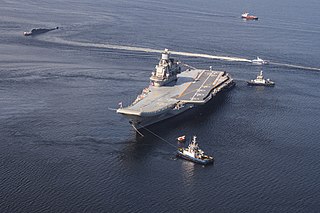
The Kuznetsov-class aircraft carrying cruiser, Soviet designation Project 1143.5, is a class of STOBAR aircraft carriers operated by the Russian and Chinese navies. Originally designed for the Soviet Navy, the Kuznetsov-class ships use a ski-jump to launch high-performance jet aircraft and arrestor gears for landing. The design represented a major advance in Soviet fleet aviation over the Kiev-class carriers, which do not have full-length flight deck and could only launch VSTOL aircraft. The Soviet Union's classification for the class was as a heavy aircraft-carrying cruiser, which permits the ships to transit the Turkish Straits without violating the Montreux Convention. However, the Chinese variants are classified as aircraft carriers.

An anti-ship missile (AShM) is a guided missile that is designed for use against ships and large boats. Most anti-ship missiles are of the sea-skimming variety, and many use a combination of inertial guidance and active radar homing. A large number of other anti-ship missiles use infrared homing to follow the heat that is emitted by a ship; it is also possible for anti-ship missiles to be guided by radio command all the way.

The Russian navy is the naval arm of the Russian Armed Forces. It has existed in various forms since 1696; its present iteration was formed in January 1992 when it succeeded the Navy of the Commonwealth of Independent States.
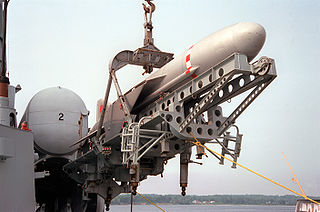
The P-15 Termit is an anti-ship missile developed by the Soviet Union's Raduga design bureau in the 1950s. Its GRAU designation was 4K40, its NATO reporting name was Styx or SS-N-2. China acquired the design in 1958 and created at least four versions: the CSS-N-1 Scrubbrush and CSS-N-2 versions were developed for ship-launched operation, while the CSS-C-2 Silkworm and CSS-C-3 Seersucker were used for coastal defence. Other names for this basic type of missile include: HY-1, SY-1, and FL-1 Flying Dragon, North Korean local produced KN-1 or KN-01, derived from both Silkworm variants and Russian & USSR P-15, Rubezh, P-20 P-22.

The Soviet designation Project 1241 Molniya are a class of Russian missile corvettes. They have the NATO reporting name Tarantul. These ships were designed to replace the Project 205M Tsunami missile cutter.

The Baltic Fleet is the fleet of the Russian Navy in the Baltic Sea.

A stealth ship is a ship that employs stealth technology construction techniques in an effort to make it harder to detect by one or more of radar, visual, sonar, and infrared methods.
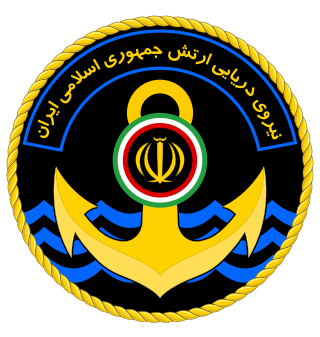
The Islamic Republic of Iran Navy or Iranian Navy, officially abbreviated NEDAJA, is the naval warfare service branch of Iran's regular military, the Islamic Republic of Iran Army (Artesh). It is one of Iran's two maritime military branches, alongside the Navy of the Islamic Revolutionary Guard Corps (IRGC).

The Steregushchiy class, Russian designation Project 20380, is a class of corvettes being built for the Russian Navy. Designed by the Almaz Central Marine Design Bureau, subsequent vessels were built to an improved design, incorporating the Zaslon-Redut SAM system. The ship full displacement and dimensions are large for a corvette, thus it is designated as a frigate by NATO. The Steregushchiy class has been further developed into the Gremyashchiy class and Project 20386 subclasses. The export variant is known as Project 20382 Tigr.
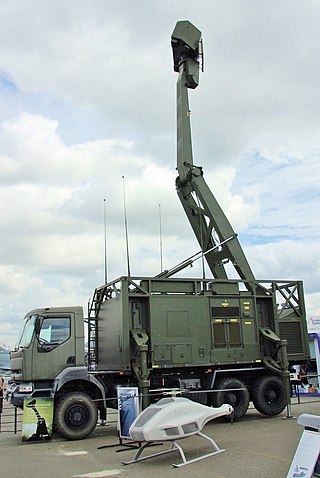
The Saab Giraffe Radar is a family of land and naval two- or three-dimensional G/H-band passive electronically scanned array radar-based surveillance and air defense command and control systems. It is tailored for operations with medium- and Short Range Air Defense (SHORAD) missile or gun systems, or for use as gap-fillers in a larger air defense system.
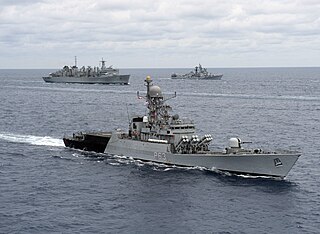
Kora-class corvettes are guided missile corvettes, in active service with the Indian Navy and the National Coast Guard of Mauritius. Four vessels were built at Garden Reach Shipbuilders and Engineers (GRSE) and outfitted at Mazagon Dock Limited (MDL).

The Pohang-class PCC is the low-end complement of the high-low mix domestic naval construction plan of the Republic of Korea Navy under the 1st Yulgok Project (1974-1986) for the Republic of Korea Armed Forces. It was originally planned as a Batch II production of Donghae-class corvette, but many changes on overall design, notably applying the hull design of Ulsan-class frigate, reclassified the ship to its own class. The ship is designed for patrolling maritime border, including the Northern Limit Line, protecting the littoral zone, and combating the North Korean vessels.

The Tuo Chiang-class corvette is a Taiwanese-designed class of fast and stealthy multi-mission corvettes built for the Republic of China (Taiwan) Navy. It is designed to counter the numerous and increasingly sophisticated People's Liberation Army Navy ships by utilizing hit-and-run tactics, and thus features clean upper structure design with very few extrusions to reduce radar signature, pre-cooled engine exhaust to reduce infrared signature, and a reduced visual signature to reduce chance of detection.

The Gremyashchiy class, Russian designation Project 20385, is an update of the Steregushchiy-class corvettes of the Russian Navy at a cost of 150 million $. This follow-on project was designed by the Almaz Central Marine Design Bureau in Saint Petersburg. The first ship was laid down on 26 May 2011 and the official laying down ceremony took place on 1 February 2012. Although classified as corvettes by the Russian Navy, these ships carry sensors and weapon systems akin to frigates and, as a result, are so classified by NATO.

SMART-S Mk2(Signaal Multibeam Acquisition Radar for Tracking, S band Mk2) is a naval medium to long-range air and surface surveillance multibeam passive electronically scanned array 3D radar designed by Thales Nederland, formerly Hollandse Signaalapparaten (Signaal). While the original SMART-S radar was only produced in small numbers, SMART-S Mk2 is very successful. Only six years after its introduction, 30 systems were sold to navies all over the world. SMART-S Mk2 radar is equipped with transmitter/receiver (T/R) modules manufactured by Turkish defence company Aselsan. The radar transmitter/receiver (T/R) modules for the radar are purchased by Thales from Aselsan.

The Ada class is a class of anti-submarine corvettes developed primarily for the Turkish Navy during the first stage of the MILGEM project. The Turkish Navy has commissioned all four Ada-class corvettes.

The Karakurt class, Russian designation Project 22800 Karakurt, is a new class of Russian corvettes which have been entering service with the Russian Navy since 2018.
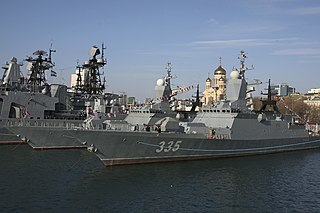
Gromkiy is a Steregushchiy-class corvette of the Russian Navy.

Merkury is a Steregushchiy-class corvette of the Russian Navy. The original name for the corvette was Retiviy prior to 2021.

The HDC-3100 Future Corvette is a class of corvettes being designed and built by Hyundai Heavy Industries (HHI) for the Philippine Navy.




















